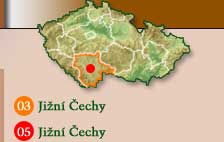|
|

ZLENICE - WATCHTOWER [ Hrad nebo zřícenina hradu ]Although the history of Zlenice Castle does not exceed two centuries, it is an interesting and, for Czech medieval history, also a typical example of a nobleman’s life from the reign of Jan Lucemburský to the King associated with the Challice movement, Jiří of Poděbrady.
Zlenice Castle was established after 1300 on a rock promontory above the confluence of the Mnichovický potok and the Sázava river. The name of Zlenice was mentioned first in 1318 in connection with Oldřich of Zlenice. The castle was named after the deserted settlement of Zlenice on the opposite bank of the Sázava river. The current form of architecture of the castle can definitely be traced back to the first half of the 14th century. Jan of Zlenice took his name after the castle in 1351. In the same year he forfeited the castle as part of a loan from brothers Štěpán and Ješek of Tetín. The local stretch of Posázaví belonged at the beginning of the 2nd half of the 14th century the noblemen of Dubá, who also got Zlenice Castle. Ondřej IV of Dubá and Zlenice who was the owner of the Zlenice Estate between 1361 - 1412 is even nowadays considered to be one of the most significant members of Czech aristocracy during the reign of King Karel IV. Ondřej IV was the most senior judge in the Czech Kingdom and he is an author of the book ‘Výklad na právo zemské české’ which was the Legal Code for the Czech Lands. In 1377 Zlenice became a feudal property. When Ondřej IV. of Dubá and Zlenice died (1412), the castle was passed as a feudal tenure to the King. It was then acquired by Boček of Poděbrady, Senior, and Půta of Častolovice. Půta, in 1415, sold the castle to Kuneš of Konojedy who also bought Boček’s right. The estate remained in Kuneš’ family until 1444 when his daughter Běta forfeited it to Zdeněk Kostka of Postupice and the previously mentioned Kuneš Rozkoš of Dubá. This gave rise to a long-term conflict between the creditors and after Kostka’s death the noblemen of Ostupice took control of the management of the castle (his uncle Zdeněk Kostka of Postupice and, a year later, Mikeš of Postupice). In 1456 Mikeš of Postupice sold the whole estate to brothers Burian, Zdeněk and Mikuláše Trčka of Lípa. Zlenice was bought from them again by Zdeněk Kostka of Postupice in 1463. The total decline of the castle occurred between 1464 - 1466 during his reign. The castle was released from feudal hold in 1465 in exchange for Kostka’s Castle of Myšín. In connection with this event, Zlenice is mentioned to be deserted and in ruins. Deserted Zlenice was then part of the Kostka’s estate of Komorní Hrádek. In 1648 it was separated from the original estate and allocated to the Mrač estate as together purchased in 1725 to expand the Konopiště estate.
Only ruins remain from Zlenice Castle, which is generally referred to as a Watchtower due to the dominating ruin of a tower. The access to the castle leads from the rear sloping part of the promontory across the outer ward to the centre of the castle which was divided from the promontory by a wide moat. The outer ward and the rear sloping part of the promontory were divided with a wide mound with a moat behind. The entrance to the outer ward probably lead through a tower gate, there was a building with two sections in the southern part of the outer ward. The ground plane of the centre of the castle was an irregular pentagon shape. To enter the inner castle from the outer ward, there was a passage leading across a wide moat dug out of rock, possibly leading across a firm bridge a part of which could be withdrawn. The bridge lead to a gate with a square ground plane to which the drawbridge could be laid. It is likely that there was another floor above the entrance on both sides of which there are seats. The previous rampart has been partly preserved above the moat at each side of the gate. The most important part of the inner castle is a big tower with an oblong-trapezoid ground plan that has been preserved up to the height of 14 meters and which can be found in the north-western wall. Most of the south western wall is in ruins. In the part that has been preserved we can detect four floors with remains of windows.
součást prezentačního a rezervačního systému Doménová koule ®
|
|






